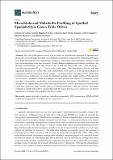Por favor, use este identificador para citar o enlazar a este item:
http://hdl.handle.net/10261/173574COMPARTIR / EXPORTAR:
 SHARE SHARE
 CORE
BASE CORE
BASE
|
|
| Visualizar otros formatos: MARC | Dublin Core | RDF | ORE | MODS | METS | DIDL | DATACITE | |

| Título: | Microbiota and metabolite profiling of spoiled spanish-style green table olives |
Autor: | Castro Gómez-Millán, Antonio de CSIC ORCID ; Sánchez Gómez, Antonio Higinio CSIC ORCID CVN ; López-López, Antonio CSIC ORCID ; Cortés Delgado, Amparo CSIC ORCID ; Medina Pradas, Eduardo CSIC ORCID ; Montaño, Alfredo CSIC ORCID | Palabras clave: | Green table olives Spoilage Microbial community DNA sequencing SPME-GC-MS Metabolite composition Cardiobacteriaceace Ruminococcus |
Fecha de publicación: | 31-oct-2018 | Editor: | Multidisciplinary Digital Publishing Institute | Citación: | Metabolites 8(4): 73 (2018) | Resumen: | The aim of the present study was to assess the malodorous spoilages of Spanish-style green table olives through microbial and metabolite composition using current measuring techniques (e.g., high-throughput DNA sequencing, headspace solid-phase microextraction combined with gas chromatography-mass spectrometry). Under different alkaline and washing conditions, the spoilage fermentations were reproduced with Gordal and Manzanilla olive cultivars using a low salt concentration (71 g L−1 NaCl) in the initial brine. The degradation of lactic acid and significant increases in volatile fatty acids and phenols were found in all the spoiled samples in comparison with the unspoiled control samples. According to high-throughput DNA sequencing, Cardiobacteriaceae and Ruminococcus were the dominant bacteria in the spoiled samples. PLS regression and Pearson’s correlation coefficient analyses revealed positive and negative correlations among microbial communities, metabolites, and sensory spoilage descriptors. Notably, the “zapatera” descriptor was significantly associated with Propionibacterium, which was positively correlated with acetic acid, propionic acid, succinic acid, and methyl propanoate; while the “butyric” descriptor exhibited a significant positive relationship with the genus Ruminococcus, which gave an almost significant correlation with propionic and butyric acids. | Versión del editor: | https://doi.org/10.3390/metabo8040073 | URI: | http://hdl.handle.net/10261/173574 | DOI: | 10.3390/metabo8040073 | E-ISSN: | 2218-1989 |
| Aparece en las colecciones: | (IG) Artículos |
Ficheros en este ítem:
| Fichero | Descripción | Tamaño | Formato | |
|---|---|---|---|---|
| metabolites-08-00073.pdf | 2,36 MB | Adobe PDF |  Visualizar/Abrir |
CORE Recommender
PubMed Central
Citations
14
checked on 22-abr-2024
SCOPUSTM
Citations
30
checked on 16-abr-2024
WEB OF SCIENCETM
Citations
26
checked on 29-feb-2024
Page view(s)
424
checked on 22-abr-2024
Download(s)
237
checked on 22-abr-2024

